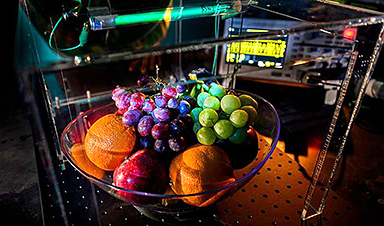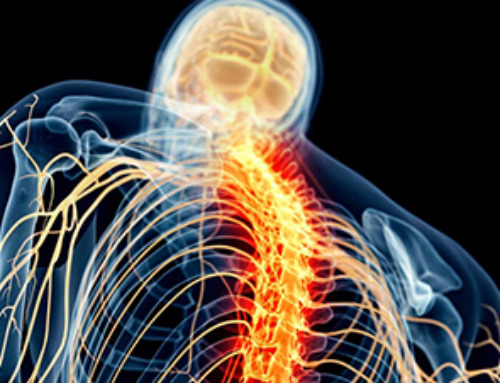Scientists at the University of Illinois Urbana-Champaign have developed a portable, self-powered ultraviolet-C device called the Tribo-sanitizer that can inactivate two of the bacteria responsible for many foodborne illnesses and deaths.
The bacteria selected as testing targets are two of the most common causes of serious foodborne illness outbreaks in the U.S. Escherichia coli produces toxins that can cause severe abdominal cramps, fever, bloody diarrhea, and kidney failure, and Listeria monocytogenes can cause listeriosis, which has the highest rates of hospitalization and mortality of any foodborne illness.
The team assessed the Tribo-sanitizer’s decontamination capability with bacteria in liquids and on three solids—fresh apple peels, romaine lettuce, and polyethylene terephthalate, commonly known as PET, a popular material for food and beverage packaging.
The results indicated that the Tribo-sanitizer had strong potential to meet the Food and Drug Administration’s sanitization standards. Specifically, the device “achieved reductions of at least 99.999% on the E. coli strain in buffer solution and on PET, demonstrating the Tribo-sanitizer’s excellent decontamination ability,” said corresponding author Yi-Cheng Wang, a professor of food safety and engineering.
On produce, the device achieved smaller but still useful reductions of about 99.98% for the E. coli bacteria 99.9% for L. monocytogenes on the apple peels, and 99.8% for E. coli and 98% for L. monocytogenes on romaine lettuce, according to the paper.
These outcomes “are comparable to those reported in other studies that utilized UV light with a commercial power source for the decontamination of fresh produce,” said doctoral student Zachary (Zhenhui) Jin, who was the co-first author of the paper with alumnus Fujunzhu Zhao. Graduate student Longwen Li also participated in the study.
While light-based technologies like Tribo-sanitizer’s lamp “can be very effective when surfaces are directly exposed to the light source,” Wang said they may not adequately decontaminate areas that are not directly illuminated, such as uneven or rough surfaces on lettuces and apple peels.
“This could be addressed by incorporating other decontamination methods or using multiple light sources at different angles,” he said. “That is one of the future directions we are working on. And if properly incorporated into existing facilities such as transportation or storage units, the Tribo-sanitizer could potentially provide continuous decontamination throughout the supply chain without the need for commercial power.”
Although the length of time needed to achieve a 99.999% reduction in E. coli bacteria was long—currently 90 minutes—Jin said that the device’s potential to achieve continuous decontamination, such as within trucks on the highway, means that this extended time should not be seen as a major drawback. The team is continuing its efforts to improve the Tribo-sanitizer, and “this time can be expected to be much shorter in the future,” he said.
According to the World Health Organization, foodborne illness affects almost 600 million people annually, resulting in 420,000 deaths. The economic cost of dealing with the consequences of food contamination is more than $15.6 billion per year in the U.S. and $110 billion in low- and middle-income countries, according to estimates by the U.S. Department of Agriculture and the WHO, respectively. Wang said that the Tribo-sanitizer represents a novel means of alleviating these problems.
Consumers could use Tribo-sanitizers at home to sanitize surfaces, foods, and more because “the estimated cost of the materials used to build the device is less than $70,” Jin said.
The device’s self-powered character also gives it “excellent potential for use in low-resource settings such as natural disaster areas and conflict zones where electricity is absent or unreliable,” Li said.
More information: Zhenhui Jin et al, Tribo-sanitizer: A portable and self-powered UV device for enhancing food safety, Nano Energy (2023). DOI: 10.1016/j.nanoen.2023.108675
News
3D-printed implant offers a potential new route to repair spinal cord injuries
A research team at RCSI University of Medicine and Health Sciences has developed a 3-D printed implant to deliver electrical stimulation to injured areas of the spinal cord, offering a potential new route to [...]
Nanocrystals Carrying Radioisotopes Offer New Hope for Cancer Treatment
The Science Scientists have developed tiny nanocrystal particles made up of isotopes of the elements lanthanum, vanadium, and oxygen for use in treating cancer. These crystals are smaller than many microbes and can carry isotopes of [...]
New Once-a-Week Shot Promises Life-Changing Relief for Parkinson’s Patients
A once-a-week shot from Australian scientists could spare people with Parkinson’s the grind of taking pills several times a day. The tiny, biodegradable gel sits under the skin and releases steady doses of two [...]
Weekly injectable drug offers hope for Parkinson’s patients
A new weekly injectable drug could transform the lives of more than eight million people living with Parkinson's disease, potentially replacing the need for multiple daily tablets. Scientists from the University of South Australia [...]
Most Plastic in the Ocean Is Invisible—And Deadly
Nanoplastics—particles smaller than a human hair—can pass through cell walls and enter the food web. New research suggest 27 million metric tons of nanoplastics are spread across just the top layer of the North [...]
Repurposed drugs could calm the immune system’s response to nanomedicine
An international study led by researchers at the University of Colorado Anschutz Medical Campus has identified a promising strategy to enhance the safety of nanomedicines, advanced therapies often used in cancer and vaccine treatments, [...]
Nano-Enhanced Hydrogel Strategies for Cartilage Repair
A recent article in Engineering describes the development of a protein-based nanocomposite hydrogel designed to deliver two therapeutic agents—dexamethasone (Dex) and kartogenin (KGN)—to support cartilage repair. The hydrogel is engineered to modulate immune responses and promote [...]
New Cancer Drug Blocks Tumors Without Debilitating Side Effects
A new drug targets RAS-PI3Kα pathways without harmful side effects. It was developed using high-performance computing and AI. A new cancer drug candidate, developed through a collaboration between Lawrence Livermore National Laboratory (LLNL), BridgeBio Oncology [...]
Scientists Are Pretty Close to Replicating the First Thing That Ever Lived
For 400 million years, a leading hypothesis claims, Earth was an “RNA World,” meaning that life must’ve first replicated from RNA before the arrival of proteins and DNA. Unfortunately, scientists have failed to find [...]
Why ‘Peniaphobia’ Is Exploding Among Young People (And Why We Should Be Concerned)
An insidious illness is taking hold among a growing proportion of young people. Little known to the general public, peniaphobia—the fear of becoming poor—is gaining ground among teens and young adults. Discover the causes [...]
Team finds flawed data in recent study relevant to coronavirus antiviral development
The COVID pandemic illustrated how urgently we need antiviral medications capable of treating coronavirus infections. To aid this effort, researchers quickly homed in on part of SARS-CoV-2's molecular structure known as the NiRAN domain—an [...]
Drug-Coated Neural Implants Reduce Immune Rejection
Summary: A new study shows that coating neural prosthetic implants with the anti-inflammatory drug dexamethasone helps reduce the body’s immune response and scar tissue formation. This strategy enhances the long-term performance and stability of electrodes [...]
Scientists discover cancer-fighting bacteria that ‘soak up’ forever chemicals in the body
A family of healthy bacteria may help 'soak up' toxic forever chemicals in the body, warding off their cancerous effects. Forever chemicals, also known as PFAS (per- and polyfluoroalkyl substances), are toxic chemicals that [...]
Johns Hopkins Researchers Uncover a New Way To Kill Cancer Cells
A new study reveals that blocking ribosomal RNA production rewires cancer cell behavior and could help treat genetically unstable tumors. Researchers at the Johns Hopkins Kimmel Cancer Center and the Department of Radiation Oncology and Molecular [...]
AI matches doctors in mapping lung tumors for radiation therapy
In radiation therapy, precision can save lives. Oncologists must carefully map the size and location of a tumor before delivering high-dose radiation to destroy cancer cells while sparing healthy tissue. But this process, called [...]
Scientists Finally “See” Key Protein That Controls Inflammation
Researchers used advanced microscopy to uncover important protein structures. For the first time, two important protein structures in the human body are being visualized, thanks in part to cutting-edge technology at the University of [...]





















